A measuring tape is one of the most useful sewing tools and is indispensable in any sewing room. Today, a tape measure on the tailor’s neck is the same iconic professional attribute as a doctor’s stethoscope. This tape measure guide will focus on the following topics:
1. What is a tape measure for sewing?
The tape measure for sewing is usually a soft and flexible strip/ribbon with linear-measurement markings made mostly from reinforced polyester or fiberglass. The most common length of a measuring tape is 60 inches ( or 152 cm), but there are tapes for sale, for example, 100 inches long (254 cm) or even longer 120” (304 cm) which can be useful for measuring longer lengths (like curtains, quilts, and other home decor items).
2. Uses of a tape measure in sewing
A tape measure is used primarily for taking body measurements, as well as for drafting patterns, measuring fabric, laying out patterns on fabric, specifying the length of a garment, checking the size of hems, measuring curves and corners, and measuring curtains, quilts … and much more. It’s simply necessary for a seamstress to have a measuring tape at hand. Better yet, several types of different colors at once.
I have a detailed video sewing tutorial on how to use a measuring tape for taking body measurements. Check it out.
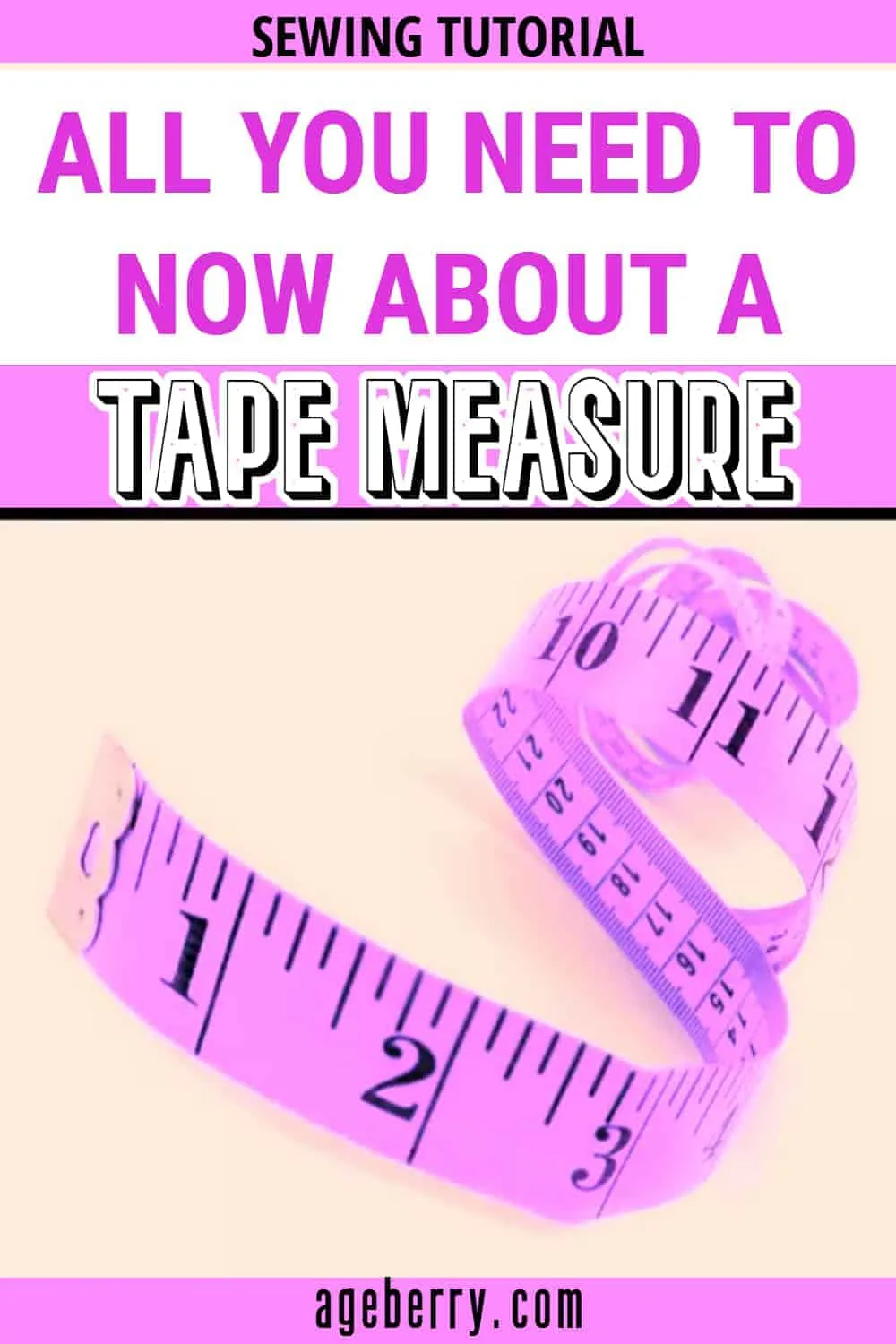
3. How to read a sewing measuring tape
As you may know, there are two main systems for measuring length – the Imperial System of Measurements where things are measured in yards, feet, and inches, and the Metric System of Measurement which uses meters, centimeters, and millimeters.
Measuring tapes in the United States and Canada usually have both metric and imperial measurement markings but some of them can have only one type of measurement.
Many in the USA have old-world roots and are used to centimeters/meters for measurements even if most patterns are in inches. I live in the USA and I find myself using the metric system quite often because all Burda magazine patterns (which I love!) are marked in metric measurements. So we have to live and work with both metric and imperial systems of measurements and try to adjust as much as possible.
The main issue with the imperial system is the absence of decimal fractions.
Let’s take an example: I have a piece of fabric 58” in width. I need to make 10 pleats using this piece of fabric. What is the distance between the pleats? Suffice to say that the pleats should be exactly 5.8” apart, but that does not translate well into inch fractions and if we take the closest approximation (5 13/16) this means one of the spaces will be in fact only 5 9/16.
In time this is no longer an issue and you get used to it. But this might be confusing if you moved to the USA for the first time and are not used to this system. I was brought up with the metric system and when I saw a tape measure in inches (for the first time) I look at it with real bewilderment. So in this guide, I want to answer the question “how to cope with both systems and transform measurements from one to another” or to be more specific “how to read a tailor’s tape measure”.
Let’s talk about measuring tape marks first. I use tapes that are marked in both inches and cm for convenience but since I use often Burda patterns I also have some older tapes that are marked only in centimeters. I prefer tapes that are marked on both sides with both metric and imperial units like this one here and all my newer tapes are like this. How many do I have? Honestly, I don’t know!
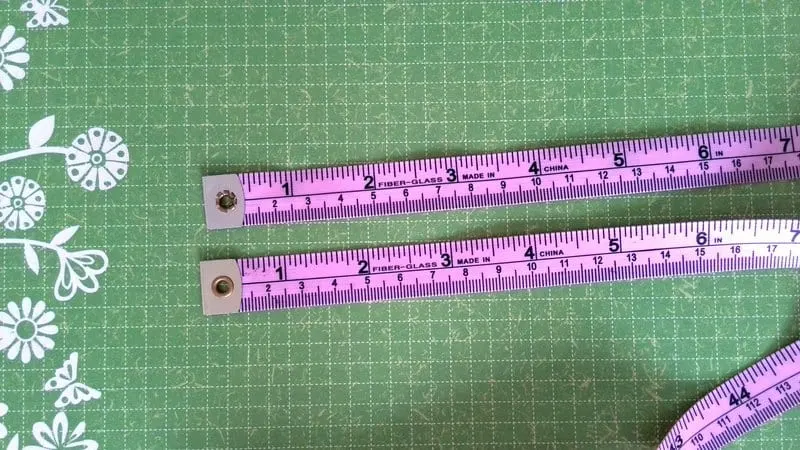
How to read a tape measure in millimeters
The markings on it are applied with the main divisions with an interval of 1 cm and intermediate – 1 mm.
A centimeter is divided into 10 equal parts – millimeters and one can express fractions with a decimal point (2.3cm – 2cm 3mm or 23 mm).
How to read a sewing tape measure in inches
The markings on it are applied with the main divisions with an interval of 1 inch and intermediate – ⅛ or 1/16 in.
An inch is divided into 2, 4, 8, and 16 equal parts so the measurement in inches is something like “2 3/8” or “5 3/16”. And the decimal point doesn’t make real sense for inches.
The image below presents a section of tape divided into 1/8” subdivisions, the multiples of ¼” and ½” have longer marks.
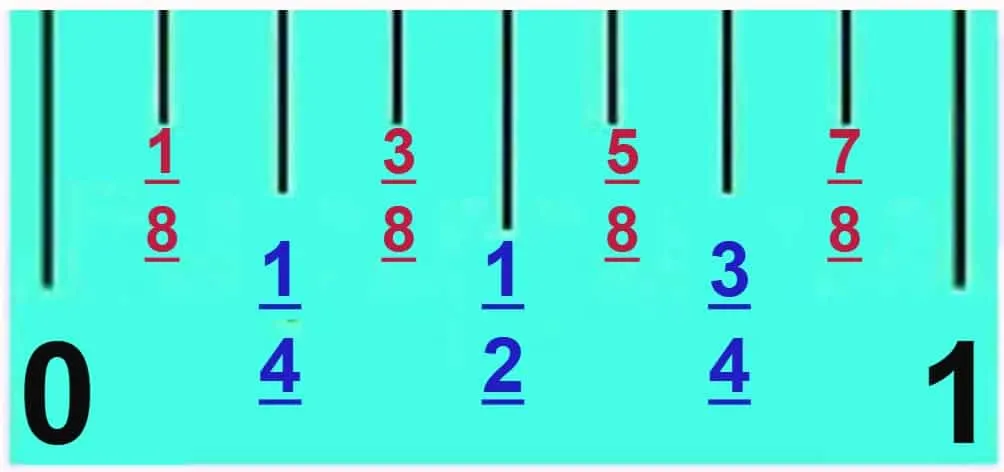
I have seen measuring tapes (for sewing) with divisions marked for ½, ¼, 1/8, and 1/16 but no finer.
The inch fractions are usually marked with a simple line so one would need to count the number of divisions to get the fractions, and I personally always had an issue with this! It is so easy to make a mistake! The image below shows a tape with 1/16” divisions, even more difficult to count. Can you pinpoint the 5/16 on a tape measure immediately? I can’t.
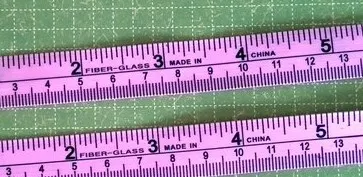
Let me give you more examples.
How to read a tape measure in 16ths
Let’s say my tape measure has 16 marks per inch and I use it to measure a dart for example. It comes out as 4 whole inches plus 5 little marks, then that is 4 and 5/16 inches.
Another example: let’s use it to measure the distance between buttonholes (check out my tutorial on making perfect buttonholes) and it comes to 3 whole inches plus 2 little marks, then it is 3 and 2/16 inches. But we will not say that the distance is 3 2/16 inches, we usually say 2/16 as ⅛, right? So our measure for the buttonholes will be 3 ⅛ inches.
Another example: let’s say we want to make a hem and it comes out as 1 whole inch plus 4 little marks, then that is 1 and 4/16 inches which we will convert to 1 ¼ inch.
Let’s say we have to find out where is ⅝ on a tape measure that has 16 marks per inch. We convert ⅝ to 16ths – that is 10/16, right? Then we have to count 10 little marks on the tape measure – that’s how we find ⅝ on the tape measure.
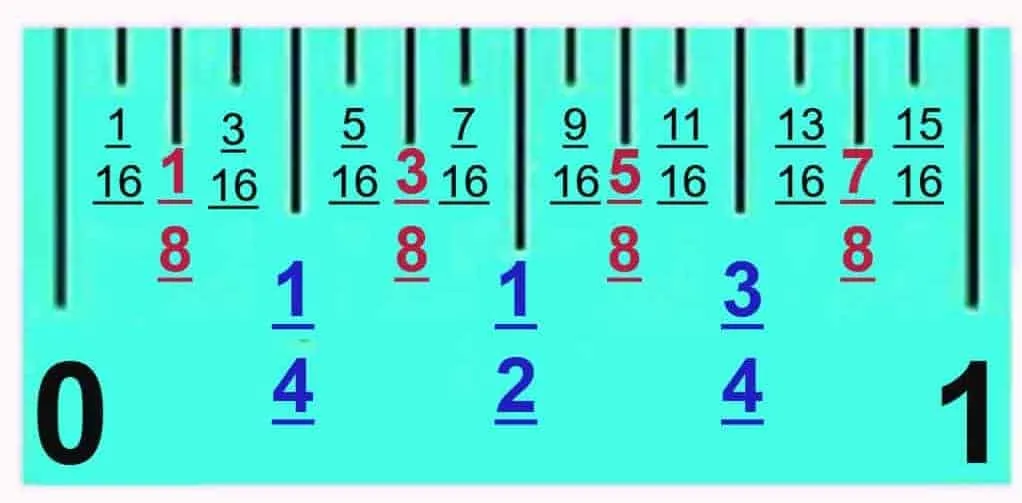
4. How to buy a measuring tape for sewing
How to buy a measuring tape for sewing? This is not difficult, but there are a few details that you must pay attention to.
Everyone who is going to seriously engage in sewing needs to choose a high-quality measuring tape with a guarantee against shrinkage and disappearing marks. The fabric measuring tape must be strong, but flexible, not twisted or stretched, and not easily torn.
Pay attention to the material of the tape – it must be strong to serve you as long as possible without stretching. Modern professional tapes are made of fiberglass and NEVER stretch. When choosing a tape measure for sewing, remember that it should be soft and flexible. A rigid measuring tape will not fit on your body or on a pattern and fabric and all measurements will turn out to be incorrect.
Choose a tape measure that scale begins directly from the edge of the tape. If the beginning of the scale is indented from the edge, you will need to constantly monitor that this indent doesn’t fall into the measurement. In any case, make sure you are measuring from the ZERO LINE.
We also recommend that you select a tape with the scale that starts with a unit 1 at both ends: then no matter what end of the tape you take, the beginning of the scale will always be in your hands.
Be sure to check the accuracy of the scale on the tape measure. Accuracy is a basic requirement for any measuring tool. The markings must be bright and clear so you can see the numbers very well.
A measuring tape scale can be applied both in inches and centimeters. A double scale can be useful to you if you often sew with patterns from magazines or websites of countries where the metric scale is adopted.
The next thing to look for when buying a measuring tape is the color. Give preference to bright colors – so it will be easier for you to look for it in the creative mess which usually happens in the sewing room where you cut fabric and sew. I often lose my tape on the table among patterns and fabric pieces. What about you? But if it’s bright pink it’s much easier to see.
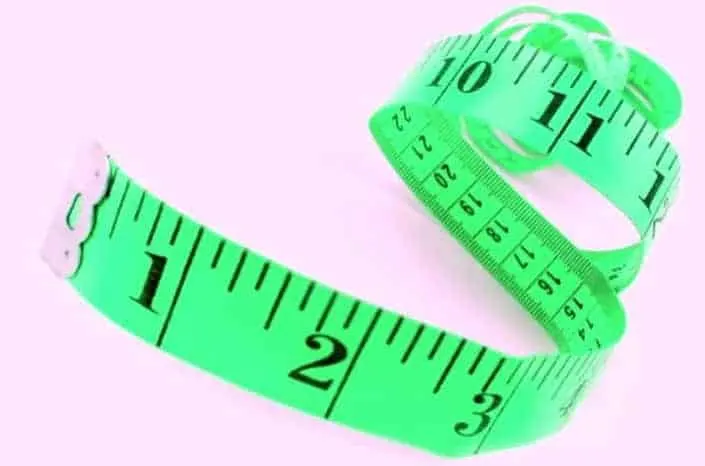
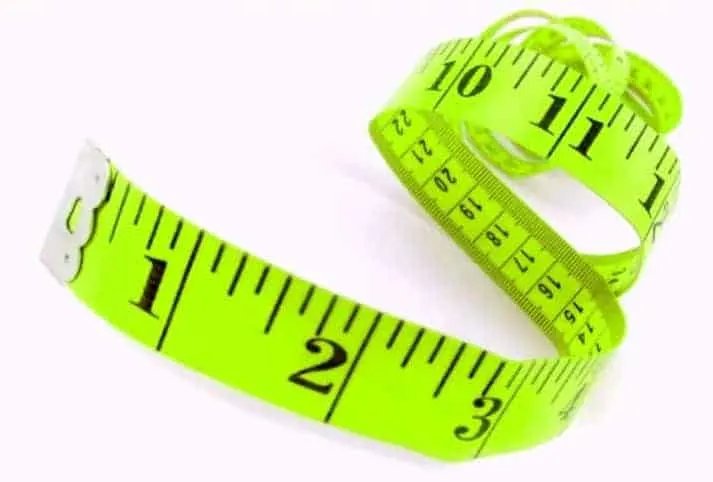
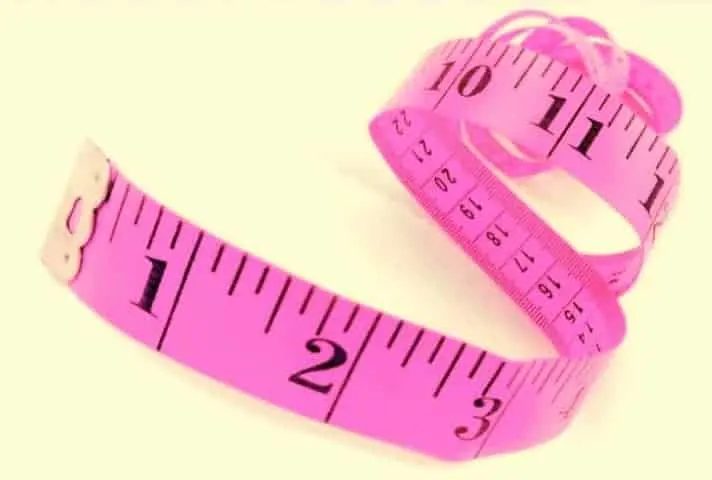
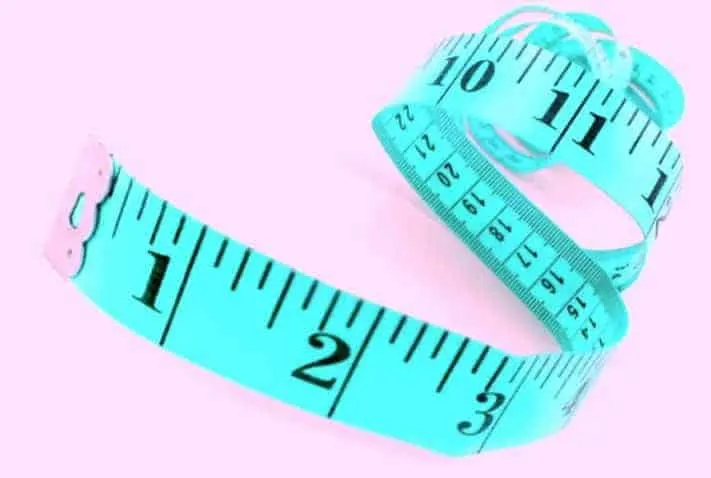
Note: Some of the links on this page are affiliate links. This means I will receive a commission if you order a product through one of my links. I only recommend products I believe in and use myself.
If a measuring tape is torn, stretched, or rubbed, do not try to repair it BECAUSE its scale indicators may become inaccurate. This sewing tool is inexpensive, so it’s better to immediately purchase a new one.
5. Measuring tape types
1. Some tapes are marked only in centimeters and millimeters.
2. Some have only inches and their fractions (in 8ths or 16ths).
3. Some have both inches and centimeters. Personally, I much prefer this type of measuring tape for sewing. Converting lengths for sewing is simple by using a tailor’s tape marked in both cm and inch. All you need to do is read the inch side corresponding to the number in centimeters. If we have to convert for example 66 cm into inches, looking at the image below we can see the result is 26 inches.
4. Two-sided tape measure. To me, this is the best tape measure because the scale starts with a unit 1 at both ends: then no matter what end of the tape you take, the beginning of the scale will always be in your hands. I think they also called them DUAL SIDED. But in the USA most stores don’t have the two-sided tape (I mean the tape with unit 1 on BOTH ends) with inch/cm markings on both sides. I bought mine in New York and I found one online. I just can’t use the other type that they sell in most fabric stores. I don’t like to lose a lot of time searching for the proper end to start measuring.
5. Measuring tapes have different lengths and widths.
The most common length is 60″ (152 cm) but longer tapes twice that size exists.
The standard width of a measuring tape is ⅝ inch and this is really helpful because the standard measurement for seam allowances for most patterns is ⅝ inch. So when I am making simple patterns (like this pattern for shorts for example, or this pattern for a simple top) I am just using the width of my measuring tape to draw seam allowances in no time flat.
6. The most common material for such tapes are reinforced polyester and fiberglass which I prefer because it doesn’t stretch. The narrow edges of the tape measure are often decorated with metal rivets that prevent it from wearing.
7. Retractable measuring tapes have a self-enclosed case which is a big plus. They can be easily carried in a purse. Choose one that pulls out easily and retracts nicely as well.
8. Cute and pretty measuring tapes always put a smile on my face. These measuring tapes are a great gift for any seamstress.
9. Adhesive measuring tapes for sewing.
These removable, adhesive-backed measuring tapes are used for marking fabric or sewing tables for quick measurements while cutting or trimming. They are printed in Imperial and Metric markings. The tape does not adhere well to damp or wet surfaces, so make sure the surface is relatively clean and dry. I use this along the edge of my sewing table for quick measurements.
The measuring tape should be stored either suspended or rolled up. It’s advisable to determine a permanent place for it so that you always know where to get it.
6. Vintage and antique measuring tapes
There are many sewing tools that have thousand-year-old history. But a flexible tape measure is a relatively young invention. Let me tell you some interesting facts about a tailor’s measuring tape. I am really wondering how they took body measurements before the invention of a measuring tape? And who was the first to propose using a fabric tape with divisions for taking measurements?
Well, I found some info that the fabric tape measure was invented in 1847 by Alexis Lavigne – the master tailor of the French Empress Maria Eugenia, the founder of the world’s first fashion school Esmod, which exists to this day.
And since then an elegant, beautifully packed measuring tape turned into a symbol of the profession of a fashion designer and a tailor.
Why measuring tapes were made mainly in a case? I think everything is simple here. Those vintage measuring tapes were made from fabric, usually silk, and had ink marks (which were printed on them manually) and of course, the case with some kind of a return mechanism provided some safety.
Below you can see images of some vintage measuring tapes. I found these images online in one Russian post with little historical information.
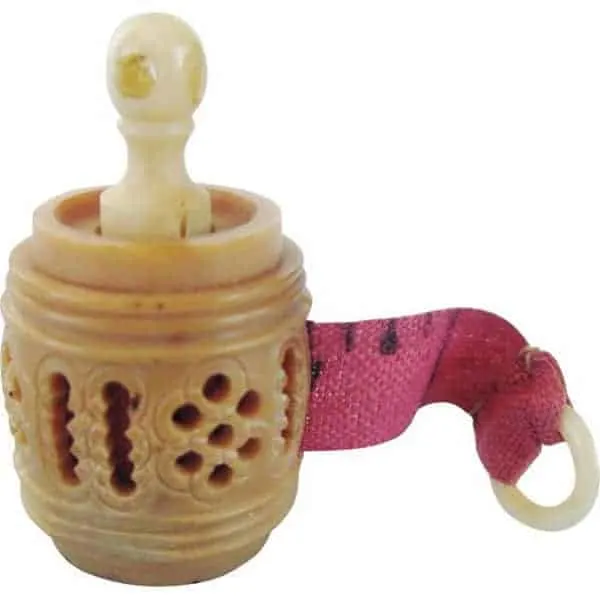
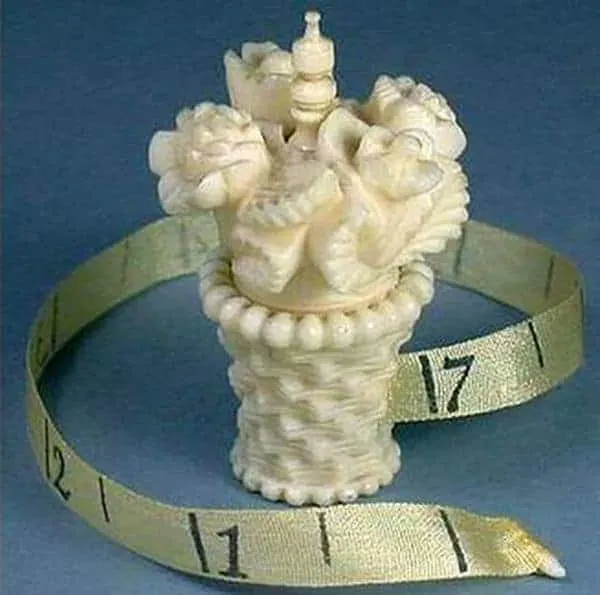
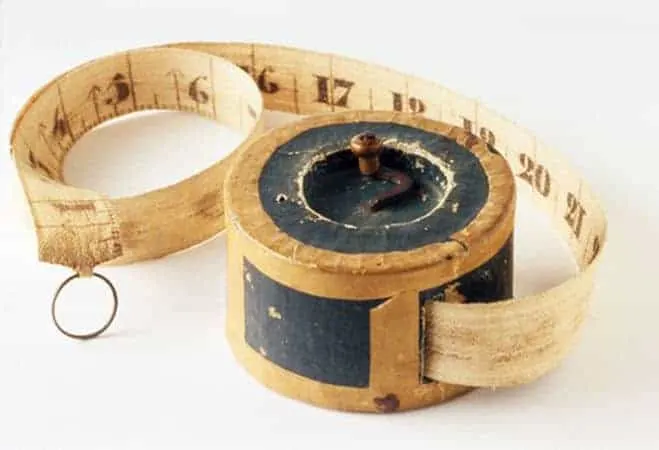
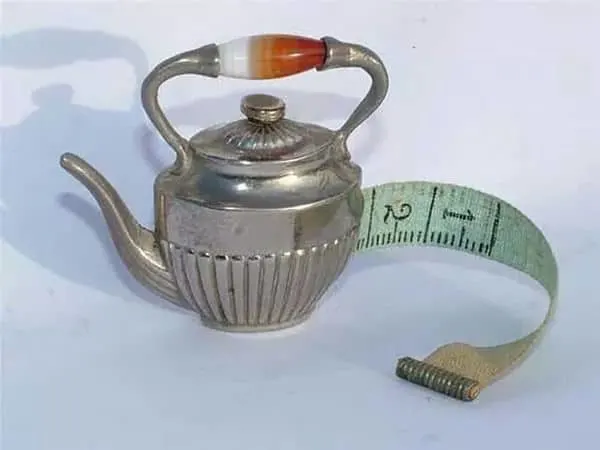
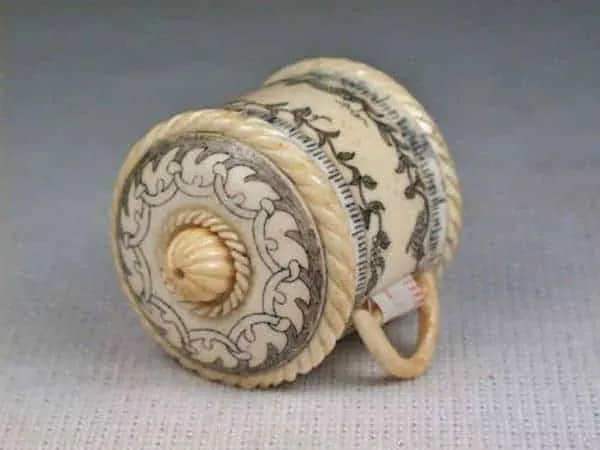
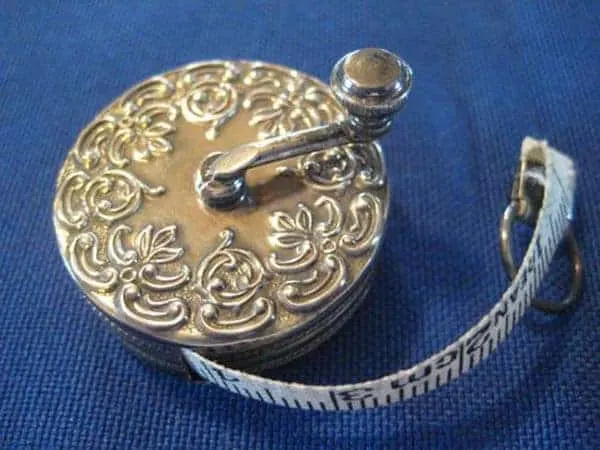
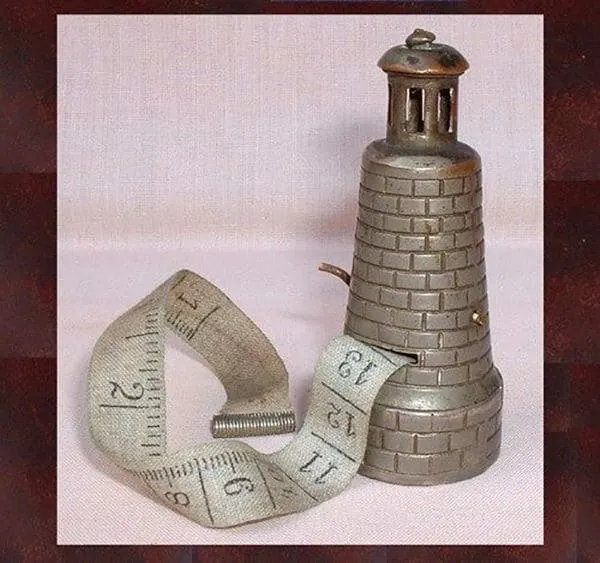
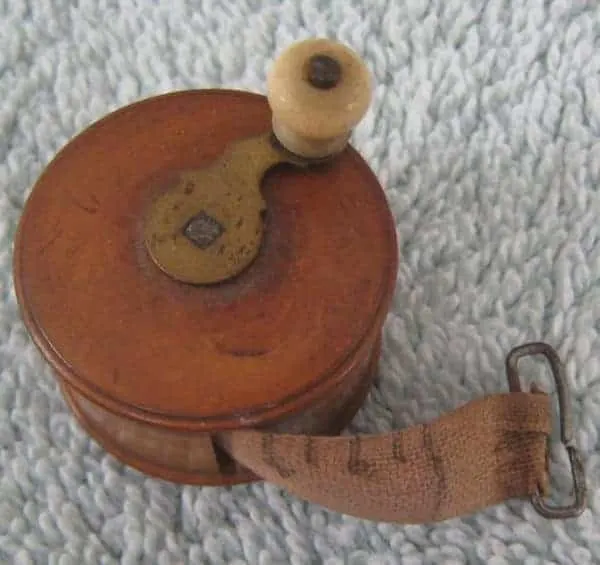
7. Tape measure chart PRINTABLE
If you want to easily convert between inches and millimeters use this chart below with equivalent in mm for inch subdivisions.
The values are rounded to the closest mm value. For example, if the actual value is 7.94 mm we have to round it up to 8 mm because in sewing the millimeter is not divided further – the millimeter is the smallest commonly used unit in the metric system. We can’t really see and use something that’s even smaller than a millimeter.
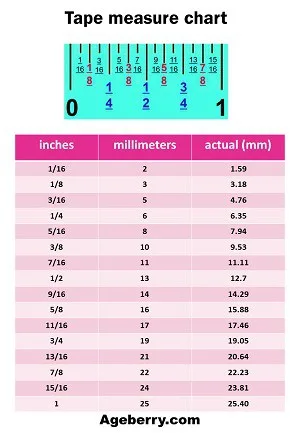
Use this printable Tape Measure Chart to easily see how to read the tape measure in 16ths.
You can quickly see how fractions of an inch correspond to millimeters without needing to memorize or calculate anything.
Did you find this tutorial helpful? If so, save this pin (see below) on your sewing board so you can come to this tutorial later when you need to know how to use a tape measure and follow me on Pinterest for more tips, tutorials, and inspiration!

latest posts
- Adorable DIY Needle Book | Easy Tutorial for Beginners
- Master the Seam Ripper: Your Ultimate Guide to Precision Stitch Removal
- Think You Know Zippers? This Installation Guide Might Surprise You
- Why Does Your Seam Ripper Have a Red Ball? Discover Its Purpose!
- Topstitching Troubles? This Simple Trick Will Turn It Around Instantly!
- How to Sew Shirring: A Step-by-Step Guide to Elastic Thread Gathering
- Are Self-Threading Needles Really Useful?
- Amazon Spring Sale: Best Choices
- Elevate Your Prom Look: A Guide to 10 Neckline Choices (2024)

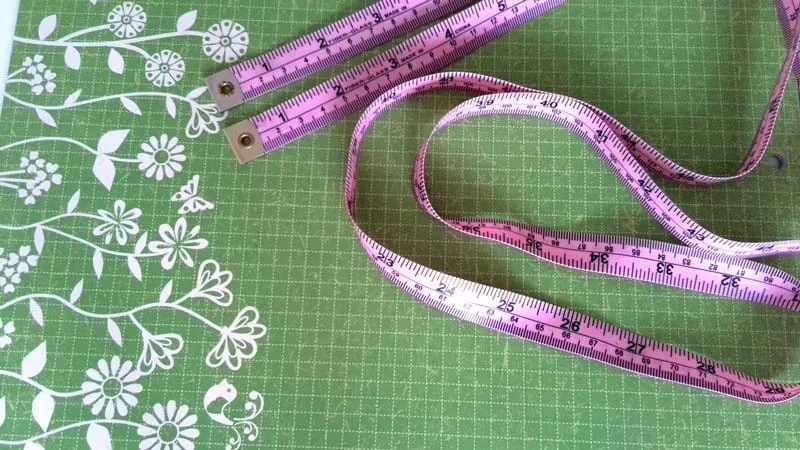
Jeannie
Wednesday 6th of September 2023
All you need to now? Should be know.
Alex
Sunday 12th of November 2023
@Olga Balasa,
The error is in the heading of your Sewing Tutorial insert.
It shows as "All You Need To NOW About A Tape Measure." But it should be KNOW instead of NOW
Olga Balasa
Sunday 15th of October 2023
Thank you, but I can't find the error?
Frances
Thursday 3rd of November 2022
I needed to know if tape measures were seeing specific & whether to buy a cloth tape measure or a retractable one— after reading your guide I’m buying both!! Informative & elevating! I love your enthusiasm for sewing!!
Olga Balasa
Sunday 13th of November 2022
Retractable tapes have the habit of breaking, so while I use them, I am not really a fan. Cloth and plastic tapes also have a drawback, they tend to get longer sometimes and lose their markings. I find that I constantly need a fresh supply of tapes of all kinds!
Bridgeen
Saturday 3rd of September 2022
As I was reading your article I kept hoping you would mention a left handed tape measure. Have you ever come across one? I have left handed rulers and I surely would love a left handed tape measure.
Krunal
Wednesday 1st of December 2021
Thanks to your post I found the tape. On amazon link the tape isn't available now as on 12/1/21. But the company that manufactures the tape is 'Hoechstmass' & do have their sales portal.